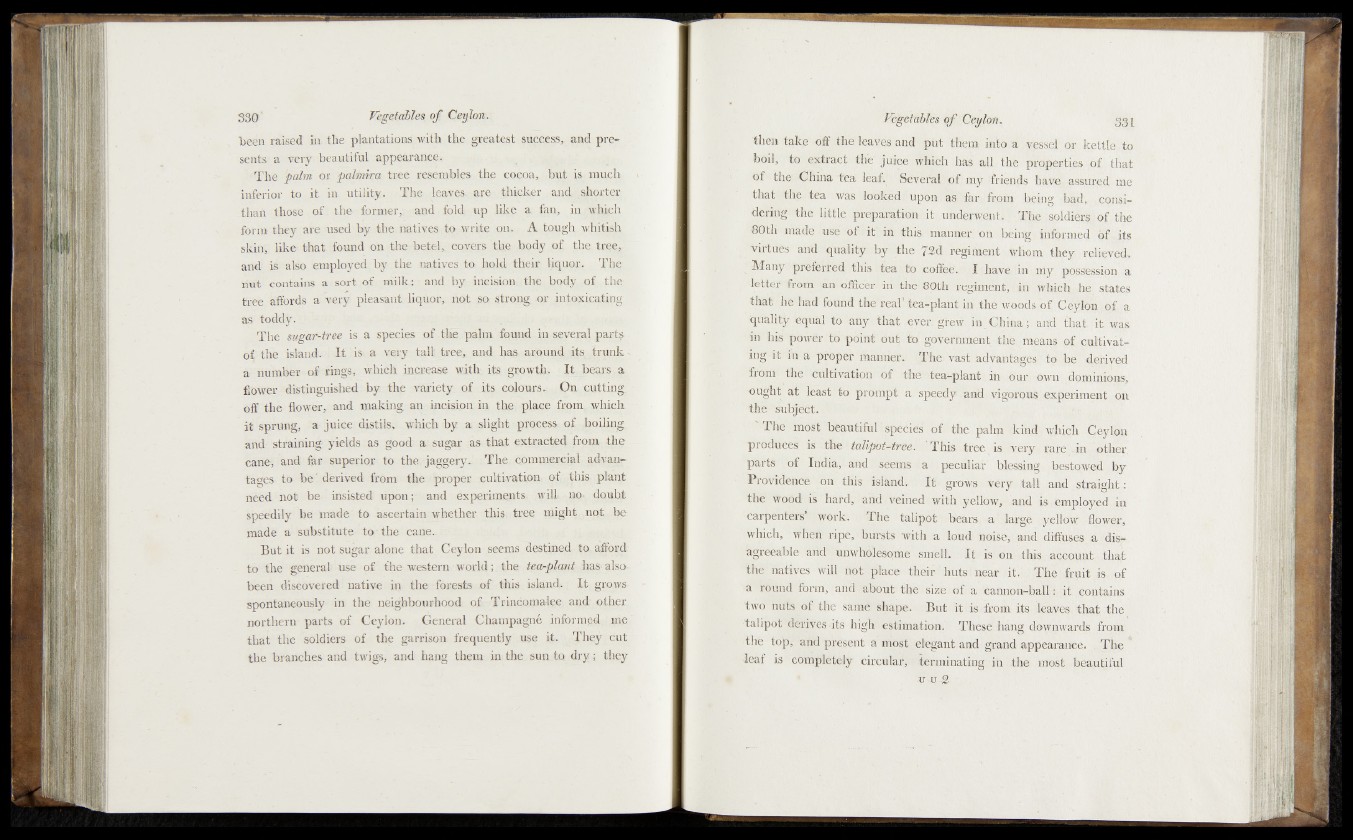
■been raised in the pknt#iQM wiffe ,%§ pea.test-succjsss,. and pre- i
sects; a Very beautiful appearance.
The Jpalm or palmira tree resembles the cocoa, but is much-
inferior to it in utility. The leaves- are thicker and shorter
than those of the former,: ; and fold up like a fan, in which
..form.' they are used by the natives to write on.. A tough whitish
skin, like that found on the betel, covers the body of the tree,
and is also employed by the natives to hold their liquor. , The
hut contains a sort of milk; and by incision, the body of the
tree affords a very pleasant liquor, not so strong or ^nloxic^hg.
as toddy. ,
The sugar-tree is a species'.of the palm found- in several pap|y
ol the island- I t • is. a y # y tall) tree,, and bag. abound ^Js^trunk -
a number »# tings, 'which mcjjease with, jg^Qyth> I t bears.a
flower^ distinguished A>T the variety of eqjours.. OiUf'CHJttipg,
off the-flower, and making an incision in, the; place |tpm r which
It spring, a jnieeidistiJSy which by ,® slight'pp^ces^pf t]mil,ung.
and straining yields ;as good a. sugar 5 ^ th a t extracted from
hahhi and #ir-saperiQE to thqjqaggery- ;.The, .QPm^^jgijl. ad-van?-
teges; to b e ’ derived from the -proper cultiyatipp» .qfj*cjfhi§; p h o t
need not be- insisted upon ;c and -experiments, wilt BP doubt
speedily b e made' to- ascertain whether this; tree might not h e
made a substitute to the cane.. .
But it is not sugar alone that Ceylon ■ seems destined to, afford
to the general- use of. the- western world; the tea-plant has- also-
been discovered native in the forests of this island. I t grows.
spontaneously in the neighbourhood of Trincomafee, and other,
northern- parts of Ceylon. General Champagn6 informed me
that tlie soldigfsi of the garrison, frequently use if. They cut
the branches and twigs, and hang them in the sun te> d ry ; they
then take off the leaves and put them into a vessel or kettfi/ffo
boil-, to’ extract‘-ftófe quiee fljph$h h a l alb, the properties,»of^ .that
b f Ihe! öhina tea leafiM^jEwferal of. my friends Kay^nassrfrpd me
that- th e tea was looked'' Upon asf far- ffojn being b ad , jCpnsi-
dering the little preparation it underwent. The soldiers of the
-80to made use of it in this, manner 011 being informed óf its
VibkfêS’ afld qu'alit^'by< [the f^W g im e n t ,%Hom they .'relieved*
Many /priferfed this (tea ifo eóffeé'. I.haVeiin^pfy p^s^sipn, a-
-letten froM uH'hffibeiniridfiri 80t’h reghnenf; in wkwh lip
that’ hè’had fódnd thë'Vehfefeaiplant'in riie Voc)d',-bfyOc'vHo'n oi.-.a
quality.equal to any that ever grew in China; and that it was
iti bfö power to point out to government the means, of cqltiv%
higm- ih a p|®p# Mand#,. The» vast bdyaniaglli t® , ^ derived
from1' the* ddltóvdtidö ‘of »the tea-plant ip puy own; »dominions,
nought akdeast! to pro'hipt a* ‘Spejfly and vigorous experiment on
‘thë'fsubjêêt. *r.
' ^Thd-c-mpSt beautiful; sp e c if o f 1 the palm «kind, whi,cK Gleylon
produéèfffs -the talipot-tree. This.strbe: is fyerygif^re,^in*.ipther
parts of Indian and v-SeömS ila , , peculiar blessing -bestowed by
vBrovidèricê on this island. It* grows,ttyCry fall and 4straight!:
the woód is * hard* and -veined with yellow, and is , employed in
•carp#'É$§fe.’WÖrk . The talipot 1 bears, '-arblarge flower,
which, whefi‘ ripe, bursts with a loud noise, and diffuses a "disk
.-tgfê'êable and unwhölesqme smell. T k is.konrthis^loqunt; ihaf
the ’natives' will riht'place their hutshnear it.-- t^hebfruit is of
•a found form, and about the size of (.a Gatmom-feallh if, .enutains
two5 nüts of the same shape. But it is from its leqyes, th at the '
•talipot derives -its- high* estimation. These' hang downwards from’
■thfe top,-» and present a most elegant and grand appearance. The ?
-leaf is completely circular terminating ifahthe. most bea-ufiful
-u-u^ ■